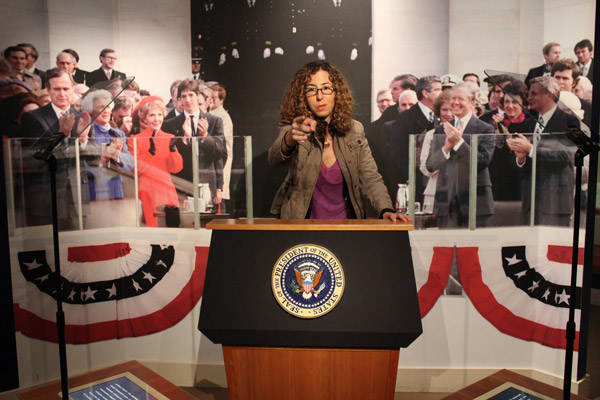Chris & Allyson vs. California (2014)
Day Eight: The Reagan Library. The Nixon Library. Downtown Brea. A visit to the Improv.
Illinois has been dining out on Abraham Lincoln for decades, but only one president really came from state. Ronald Reagan was born in the farm town of Tampico. Thanks to an itinerant and hard-drinking dad, he got to live in a few parts of Illinois, each one earthier than the last. Reagan eventually built a career around Midwestern stereotypes: straightforward communication and a positive demeanor. He was so good at being Midwestern that he achieved the dream of many Midwesterners before him. He moved somewhere else.
We woke up Friday and headed to the place where Reagan is buried. The only non-negotiable requirements I had for a California vacation were visits to the Reagan library and the Nixon library, the most prominent presidential sites on the West Coast. Allyson agreed to these terms, even when I decided it would be best to see both libraries on the same day. She might have low-grade Stockholm syndrome.
Reagan lived in Santa Barbara, but when you need scenic views at affordable prices, you go to Simi Valley. There are low, rocky mountains with views for miles, and the library is at the top of one of them. It looks like a California mission from the front: It's a low-slung building with a courtyard and ceramic roof tiles. We were there early enough that I upgraded my ticket to become a "library friend," a status that comes with an ID card and free admission to any other presidential library for a year. It also comes with a tiny bit of shame when someone asks, "Hey, what's that card in your wallet?"
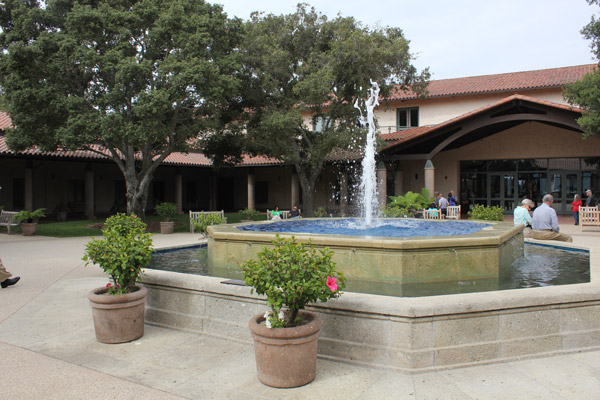
The entrance to the Reagan Library and Museum. Ranchy!

At the entrance, a photo op with our gracious hosts.
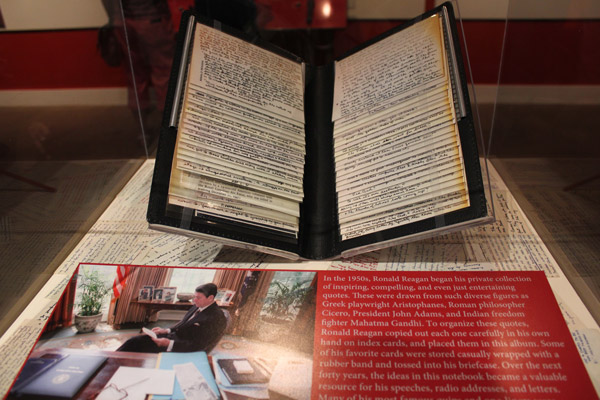
Regan's organizer, where he accumulated anecdotes and jokes for use in his speeches.

The interactive stuff in the Reagan museum is, honestly, pretty fun.

This retired "Air Force One" might be the biggest draw for the Reagan museum.
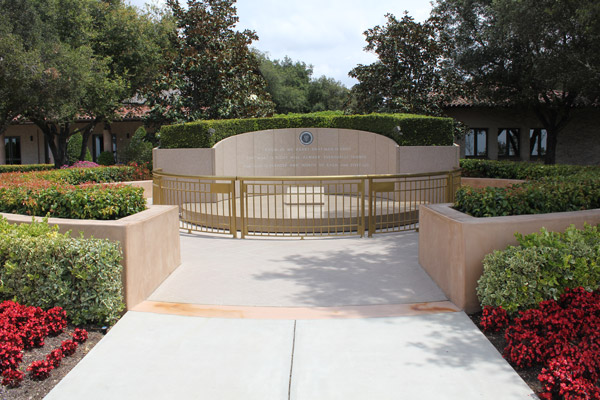
The final resting place of the Gipper.
The museum is a whitewash -- they gloss over Reagan's first marriage and all of his kids, and there's surprisingly little about Reagan's advisers or opponents. It took the combined efforts of at least six people to defeat communism and restore faith in the American dream, but the library tries to keep the spotlight entirely on Ron. They're going for the Hollywood version.
It actually works for Reagan. The story really gets going in Dixon, Ill. Reagan was a gregarious and popular kid. He was a lifeguard at a local park, where he personally made 70 future Republicans by pulling them out of the Rock River. As a young man, he landed a job as a radio announcer in Iowa. Before long he talked his way into a gig doing play-by-play for the Chicago Cubs on the local feed. On a baseball road trip to California, he auditioned with Warner Brothers, which got him into the movies.
Reagan was a Democrat back then. He wasn't a tremendous actor, but he was chosen as president of the Screen Actors Guild and took the union through some labor-management disputes in the late 1940s. For most of the 1950s, he was the host of General Electric Theater, an anthology TV show. In addition to putting him in American homes every week, the job gave Reagan the chance to visit scores of GE facilities around the country and talk to business groups as the company's goodwill ambassador. He got conservative, campaigned for Barry Goldwater in 1964 and ran for governor in 1966. Then a few minor, inconsequential things happened before his death.
The museum is slick. They have a green screen kiosk where you can do a scene with Reagan from "Knute Rockne: All American." I redefined the role of the guy who can't hide the fact that Knute is about to keel over dead. Reagan's personal diary is entirely digitized, and there is a terminal that lets you read the entry from any date. A room dedicated to the 1981 assassination attempt has the suit Reagan was wearing that day, bullet hole and all. Reagan loved collecting humorous and inspirational stories for his speeches, and you can see the small leather portfolio where he wrote them down and organized them. His hand-marked notes from the "Tear Down This Wall" speech show his personal thoughts on diction. There's an exact replica of Reagan's Oval Office. He kept portraits of George Washington and Andrew Jackson on the walls, sculptures from Frederic Remington on the shelves and jars of jelly beans on the tables. Reagan also had a simple placard on his desk; written on red leather in gold lettering is the simple phrase, "It can be done." It was either a statement of his famous optimism or the token that helped him move forward when deciding whether to get more arms to the Contras.
The highlight for most visitors has only a marginal connection to Reagan. The museum houses a retired Air Force One in a custom-built hangar with a huge glass window overlooking the countryside. The plane is a Boeing 707, so it's tiny compared to the modern Air Force One. If you've flown with Southwest, you've achieved a comparable level of luxury. A lot of ridiculously important people flew on that plane, but if any of them had illicit affairs or coke parties on board, the people at the Reagan library aren't talking. They also have a Marine One, but there aren't any good stories about the president taking it to White Castle or anyplace fun. It's a bit of a letdown.
The highlight for me is the most authentically Reagan thing imaginable. Reagan's grave is outdoors, next to a small replica of the White House's south lawn. There's a stone pavilion, and a wall behind Reagan's grave marker has a single quote: "I know in my heart that man is good, that what is right will always eventually triumph, and there is purpose and worth to each and every life."
We mulled that over while having a conservative lunch at conservative prices in the on-site cafeteria. I sold the Reagan library to Allyson as "one of the fun ones," and she agreed that we were close enough to fulfilling that promise.

In Yorba Linda, the far less scenic Nixon library.

The campus includes Nixon's birthplace, a very modest home.
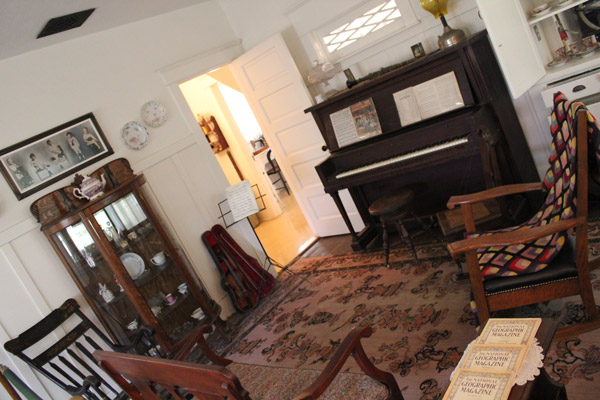
Nixon's childhood living room. Or one of them, at least. (They moved a bunch.)
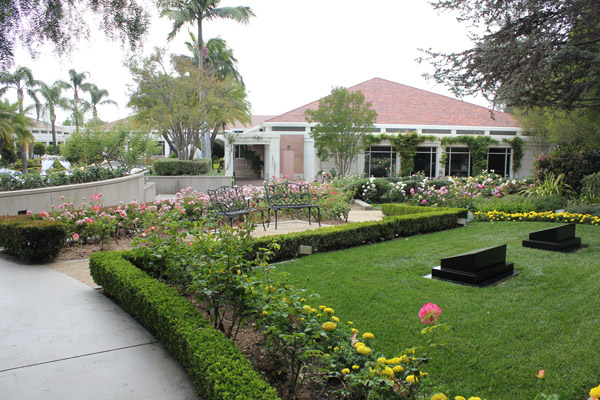
Dick and Pat, resting steps from his birthplace and the museum.
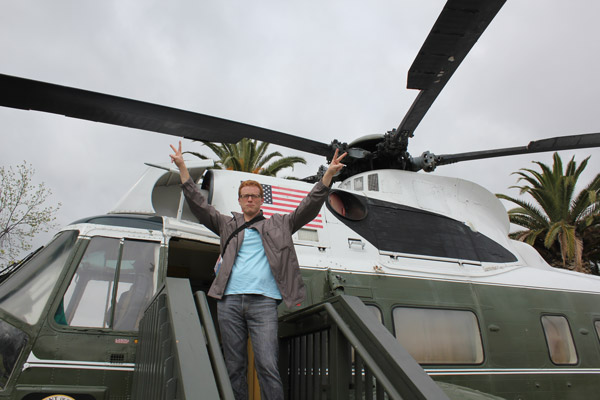
Yes, it's THAT famous helicopter.
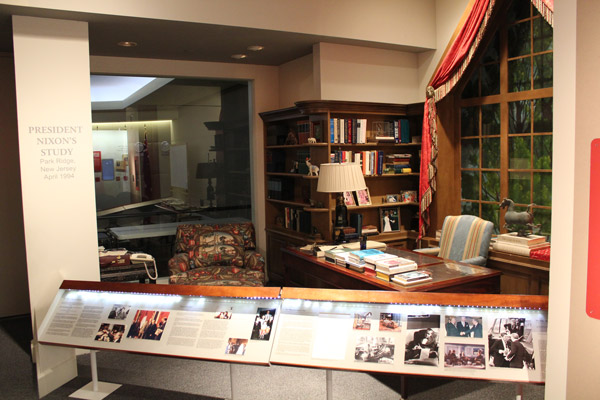
Inside (as of 2014) a replica of Nixon's New Jersey study.
That was a great development, because I sold the Nixon library as "educational," which is universally accepted as code talk for boring. We left for Yorba Linda at 1:30, hoping for a quick ride. I started having a panic attack around 2:45, as we were stopped on the highway in Pasadena. The museum closed at 5, and if you don't give yourself enough Nixon time it's the sort of thing you'll regret until you die. We cut out plans to drive past San Dimas High School (where the football rules) and stuck to the highway. Allyson talked me down and mopped my brow a few times. We rolled into the parking lot at 3:25.
It might shock you to know that Nixon's library is a little less impressive than Reagan's, as private donors weren't exactly cage-fighting each other for the right to cough up the most dough. At no point can you green-screen yourself into Nixon's episode of "Laugh-In." The physical setting is also a little less impressive, because modern Yorba Linda is a little more sprawly than a mountaintop in Simi Valley.
But the library is there for good reason. Nixon, one of the most sour presidents, was born in a Yorba Linda lemon orchard. His birth home, about 800 square feet, was ordered from a catalog and might have been built by the Quaker friends of Nixon's parents. The parents slept downstairs, and Nixon was born in their bedroom. There was one room upstairs where Nixon and his brothers slept. Dick practiced piano, violin and clarinet in the parlor; he read National Geographic, his favorite magazine, while sitting on the living room couch. The property changed hands many times over the years, but it was preserved by forward-thinking folks once Nixon started being somebody. It now holds the library, the birth home, and Nixon's grave. You can go home again.
This time, we started with the grave. Nixon is buried in a little garden, a few feet from the home where he grew up. He has a modest marker with a simple epitaph: "The greatest honor history can bestow is the title of peacemaker." Pat Nixon is right next to him, with a simpler epitaph: "Look, none of this was my idea." (In reality: "Even when people can't speak your language, they can tell if you have love in your heart.")
We moved on to a docent-led tour of the home. After that, a short path takes you to the coolest Marine One. When Nixon left the White House for good, he famously gave the "double victory salute" before hopping on the helicopter and flying off to the history books. You can actually get on that chopper, and stand by the entrance doing the double-victory while people take your picture. Children everywhere should go there and live out the fantasy. The true greatness of America is that anyone can grow up to be the most disgraced president.
Racing against the clock, we worked our way through the museum. A few areas were blocked off for a Friday night wedding -- for the right amount of money, you can take your vows in a courtyard just feet away from the corpse of the guy who opened Red China. There's a lot of reading, but they do a nice job of walking you through the Richard Nixon story.
He didn't come from a rich family. They scraped together money from farming in Yorba Linda, but it wasn't enough. The family eventually moved to Whittier, where Nixon's dad ran a grocery store and gas station. Nixon turned down the chance to go to Harvard. Instead, he stayed close to home and attended the much cheaper Whittier College. He got a scholarship to Duke's law school, and after graduating he returned home to set up a law practice. He met Pat when they were cast together in a community theater production of "The Dark Tower."
During World War II, he joined the Navy and helped run logistics in the Pacific. After the war, he was recruited by Whittier Republicans to run for the U.S. House. After a few terms serving as a leading anti-communist, he was elected to the Senate. He was young and aggressive, and that made him a great counterbalance to Dwight Eisenhower, who was old and prone to massive heart attacks. Everyone thinks of Kennedy as some insanely youthful stud, but Nixon was just four years older than JFK.
You can't talk about Nixon without mentioning all kinds of failures; it would be like reviewing a voyage on the Titanic and concluding that the cabins were a little damp. The museum actually does a nice job of owning up to most of it. They sugarcoat the Nixon-Eisenhower relationship a bit -- Ike didn't really like Nixon and gave him only tepid support in the 1960 election. But there's a big display on Watergate and a few cases dedicated to "the wilderness years," when Nixon was lurching around and licking his wounds from the apparent collapse of his public career. Nixon was a brilliant dude, but by most accounts he had a huge inferiority complex and was deeply paranoid. It didn't get better with age.
You can't have a presidential library without replica rooms. In the Nixon library, they reproduce the Lincoln study from the White House and the New Jersey office that Dick kept in his retirement, when he slowly rehabilitated his image. There are also several rooms dedicated to foreign policy, since Nixon was a total stud in that regard. We plowed through the exhibits in about 45 minutes, which is just the right amount of time for a woman forced to go to two presidential museums in a day.
Fortunately, the rest of the vacation was all on Allyson's terms. At 5'1", my wife is a titan of the entertainment industry. She usually doesn't trade on her name, but she decided to make exceptions for vacation. Using all of the clout that she amassed in 15 years of working for the DC Improv, she arranged two free passes, with a value upwards of $40, for an evening at the Brea Improv.
My wife is not very comfortable throwing her weight around. All 100 pounds of it.
But it still gave us something to do. Brea is a short drive from Yorba Linda. It was a white and rednecky area that, like most of the Los Angeles exurbs, is turning more Asian and Hispanic every day. The comedy club is in "downtown Brea," a two-block outdoor strip mall. While waiting for the show, we browsed at amazing stores that you can find only in the Los Angeles area, such as Old Navy and World Market. We decided to pass on bland businesses that were obviously chains, like the waxing joint named The Pretty Kitty.
The star of our show was Dave Attell. Allyson has known Dave for years, and I've been a big fan for years. When I went to the DC Improv for the first time, he was the headliner. He's raunchy in the best way possible, and he knows how to work a club audience like nobody's business. The comics before him were sociopaths with no redeeming social value, but Dave turned the evening into a win.
One of the best things about being a big shot in the entertainment industry is getting to hang with the stars after the show, without the pretense of having sex with them. We got to chat with Dave for a few minutes outside, in the rain, while he chain-smoked. I played the role of beautiful arm candy while my wife talked with a short Lebanese man from Long Island about everything that's wrong with the entertainment industry. It was a magical time.
